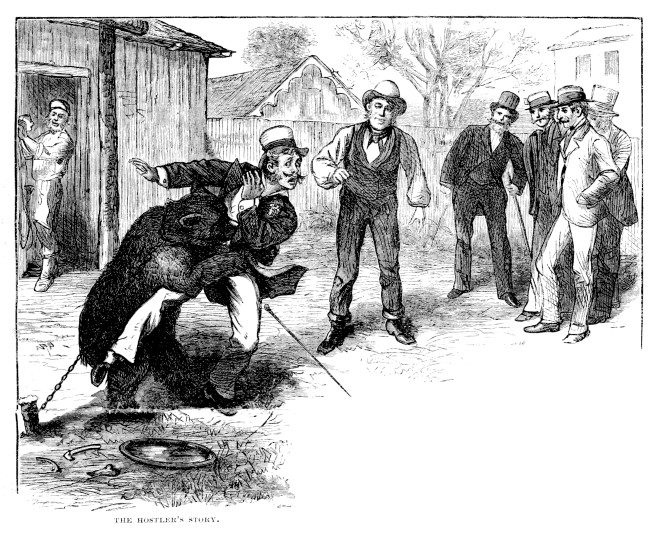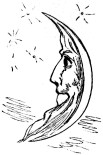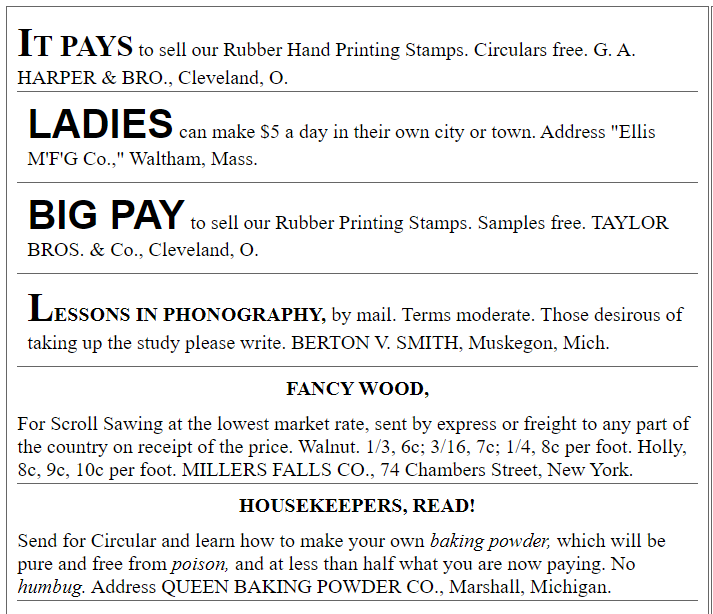
From Gutenberg Press. Org: https://www.gutenberg.org/cache/epub/22242/pg22242-images.html
Following are excerpts of some of the stories, features, and advertisements in the vintage magazine from 1879.
]
THE HOSTLER’S STORY.
By J. T. Trowbridge.
The story begins: [Note: In 1879, few were concerned about cruelty to animals.]
“What amused us most at the Lake House last summer was the performance of a bear in the back yard.
“He was fastened to a pole by a chain, which gave him a range of a dozen or fifteen feet. It was not very safe for visitors to come within that circle, unless they were prepared for rough handling.
“He had a way of suddenly catching you to his bosom, and picking your pockets of peanuts and candy,–if you carried any about you,–in a manner which took your breath away. He stood up to his work on his hind legs in a quite human fashion, and used paw and tongue with amazing skill and vivacity. He was friendly, and didn’t mean any harm, but he was a rude playfellow.
“I shall never forget the ludicrous adventures of a dandified New Yorker who came out into the yard to feed bruin on seed-cakes, and did not feed him fast enough.
“He had approached a trifle too near, when all at once the bear whipped an arm about him, took him to his embrace, and “went through” his pockets in a hurry. The terrified face of the struggling and screaming fop, and the good-natured, businesslike expression of the fumbling and munching beast, offered the funniest sort of contrast.
“The one-eyed hostler, who was the bear’s especial guardian, lounged leisurely to the spot.
‘Keep still, and he won’t hurt ye,’ he said, turning his quid. ‘That’s one of his tricks. Throw out what you’ve got, and he’ll leave ye.’
“The dandy made haste to help bruin to the last of the seed-cakes, and escaped without injury, but in a ridiculous plight,–his hat smashed, his necktie and linen rumpled, and his watch dangling; but his fright was the most laughable part of all.
“The one-eyed hostler made a motion to the beast, who immediately climbed the pole, and looked at us from the cross-piece at the top.
‘A bear,’ said the one-eyed hostler, turning his quid again, ‘is the best-hearted, knowin’est critter that goes on all-fours. I’m speakin’ of our native black bear, you understand. The brown bear aint half so respectable, and the grizzly is one of the ugliest brutes in creation. Come down here, Pomp!’
“Pomp slipped down the pole and advanced towards the one-eyed hostler, walking on his hind legs and rattling his chain.
‘Playful as a kitten!’ said the one-eyed hostler, fondly. ‘I’ll show ye.’
He took a wooden bar from a clothes-horse near by, and made a lunge with it at Pomp’s breast.
“No pugilist or fencing-master could have parried a blow more neatly. Then the one-eyed hostler began to thrust and strike with the bar as if in downright earnest.
‘Rather savage play,’ I remarked. And a friend by my side, who never misses a chance to make a pun, added,—
‘Yes, a decided act of bar-bear-ity.’==== Read the rest of the story at Gutenberg.org
CUSPADORES.
[Note that if your story was published in a magazine in 1879, your name may or may not accompany the piece. Also, your story may or may not be illustrated.]
There is probably no human weakness that awakens more derisive contempt than a false assumption of superior knowledge. The vanity of young people frequently leads them into ludicrous positions, and sometimes even into serious difficulties, through a pretence of knowing things of which they are really ignorant. The experience of one of my young friends is a case in point.
Silvia Morden is a girl of sixteen. She is both bright and pretty. Her worst fault was the one I have mentioned,–a most ridiculous mania for wishing to appear well acquainted with all subjects.
The flattery of her companions at Miss Hall’s “Young Ladies’ Academy” no doubt had something to do with this folly; for she was generous, end a great favorite with her schoolmates. It often led her into difficulties, as falsehood in any form always does, and Silvia was really becoming a confirmed liar when the little episode I am about to relate, checked her on the very brink of the precipice.
The craze for “high art decorations” had spread from the great city centres to the country town of Atwood, where Silvia’s parents lived. Of course every one understands that “high art” becomes very much diluted in its country progress, and when it appears in out-of-the-way places, where the people are neither wealthy nor well read, it is apt to degenerate into very low art, indeed.
But the Atwood girls did what they could to follow the fashions. Old ginger-jars were dragged down, covered with paint, and pasted over with beetles, and birds, and flowers, in utter disregard of the unities. Here Egyptian scarabæi were perched on an Alpine mountain; there a clay amphora, of the shape of the Greeks or Romans, was adorned with gaudy plates cut out of fashion magazines.
Read the rest of the story at Gutenberg.org

THE WOMAN IN THE MOON.
I’ve often heard of the man in the moon;
And his profile often have seen
In the almanac, drawn on the side of a lune,
Just so–with a smile serene.

But I guessed the secret the other night,
As the clouds were clearing away;
And what do you think was the wondrous sight
Which the mystery did betray?
 I fancied I saw in the crescent, half hid,
I fancied I saw in the crescent, half hid,
Fair Luna herself reclining;
Not a man in the moon, but a woman instead,
From the sky was brightly shining.
![]()

LITTLE RUDOLPH.
“;Guten morgen! Guten morgen!’
Sounded at my door,
Eager footsteps in the entry
Outside, and before
I could answer, on the threshold,
Happiest in the land,
Stood my little German neighbor,
Bowing, hat in hand!”
![]()

Enigmas, Charades, Puzzles, &c.
1.
TRANSPOSITION.
A WATER BIRD.
“Though my nest you may find swinging high in the trees,
While I rock on my greenish-blue eggs in the breeze,
Yet I fish for a living, and love water more
Than land, though I’m careful to keep near the shore.
Transposed, I’m a river, you’ll see at a glance,
In Switzerland starting, and running through France.”
THE THREE BOYS.
[Fill blanks with words to rhyme with the termination of the first line.]
“A two-letter boy, whose name was Ed,
And a three letter boy, whose nickname was —,
Were joined by their four-letter brother, named —,
One boy was quite spunky–the hair on his —
Was of a bright auburn, in fact it was —,
And fat too, he was, by being well —.
Another had eyes dull and heavy as —,
And his nose was so broad that often ’twas —.
It nearly all over his visage was —,
The third boy was lazy; he walked with a —
That made it appear that he had a great —
Of working sufficient to pay for the —
Which he ate, when he hadn’t some meat in its —.
One cold winter day these boys got a —,
Which they found snug and dry out under a —,
And, like the bad boys of which you have —,
Without their parents’ permission they —
To the high coasting hill; soon downward they —,
But upset on the way, and one made his —
In a deep drift of snow which wet every —
Of his new suit of clothes. Another one —
So much at the nose he thought himself —,
The third one, unhurt, the way homeward —,
Where for parents’ forgiveness each one humbly —.”
Advertisements




All of the above is from Project Gutenberg. org
The following is from Wikipedia


“The Youth’s Companion (1827–1929), known in later years as simply The Companion—For All the Family, was an American children’s magazine that existed for over one hundred years until it finally merged with The American Boy in 1929. The Companion was published in Boston, Massachusetts by Perry Mason & Co., later renamed “Perry Mason Company” after the founder died. The revised name first appears on the August 9, 1900 issue. From 1892 to 1915 it was based in the Youth’s Companion Building, which is now on the National Register of Historic Places.
“Through the years, publishers included Willis & Rand (Washington St., c. 1831); Olmstead & Co., (School St., c. 1857);[1] and Perry Mason & Co. (Washington St., ca.1868;[2] Temple Place, c. 1873–1888;[3][4] and Columbus Ave.; c. 1894).[5]
“In the 1890s its content was re-centered on entertainment, and it began to target adults as well as children with pieces contributed by writers such as Harriet Beecher Stowe, Mark Twain, Emily Dickinson, Booker T. Washington, and Jack London. Another innovation was a medical column for older readers. In consequence, its circulation increased one-hundredfold, with sales peaking in 1893. It was advertised in 1897 as “an Illustrated Family Paper”, having, as one person said of it, done “away with childish things”. It did, however, retain a children’s section, which included short poems and puzzles, and in faith to its beginnings, however, The Youth’s Companion did not mention nor advertise drugs or alcohol, nor did it delve much into politics; when it did, it usually did so in a humorous way.
“On September 8, 1892, the magazine published the first copy of the Pledge of Allegiance, written by staff member Francis Bellamy.
“From 1893–1907, Johnson Morton (Harvard 1886) served as an editor. In later years the magazine published articles from Willa Cather and Winston Churchill.[6]
“Erle Stanley Gardner (1889–1970) was, as a child, very fond of the magazine. When he embarked on his own writing career, Gardner borrowed the name “Perry Mason” for his famous fictional attorney-detective.[7]
“In the 1947 movie Life with Father, which is set in the 1880s, the children of the family mention reading The Youth’s Companion.”
Wikipedia